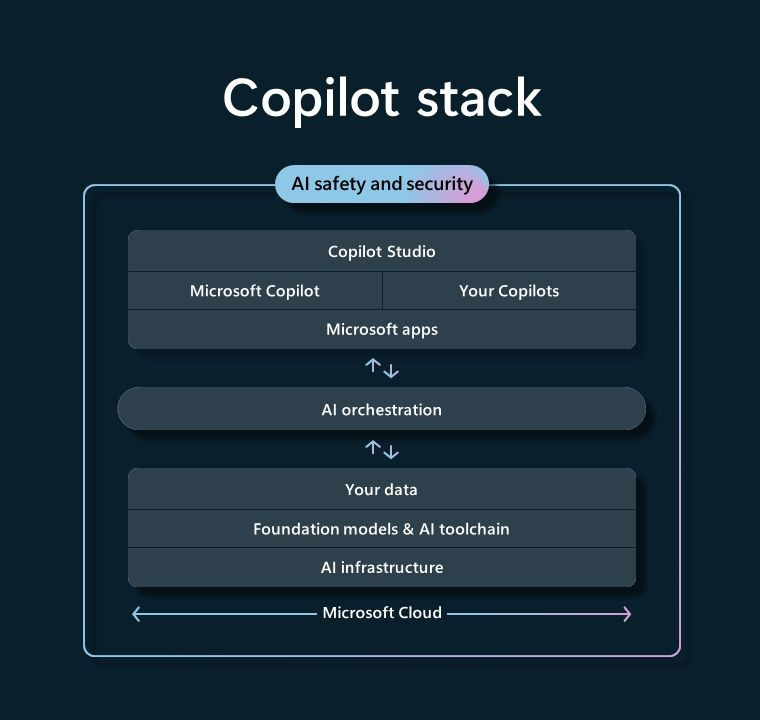The Microsoft Copilot Stack is emerging as a powerful framework for businesses developing AI-driven solutions. As organizations explore this innovative technology, understanding its architecture becomes crucial for successful implementation.
At its core, the Copilot Stack consists of four interconnected layers: User Experience, Orchestration, Execution, and Foundation Models. Each layer plays a vital role in creating intelligent, conversational AI assistants that can enhance productivity and decision-making across various industries.
In this blog post, we’ll explore these four layers, demystifying the Copilot Stack and providing insights into how it can empower your organization’s AI initiatives.

User Experience Layer
The User Experience Layer is the front line of the Copilot Stack, focusing on the interaction between users and the AI assistant. Unlike traditional interfaces with screens and buttons, copilots rely on conversational design. This layer is responsible for interpreting user queries, providing clear responses, and maintaining a natural flow of dialogue.
Kay aspects of the User Experience Layer include:
- Conversational Design: Crafting intuitive dialogue flows that feel natural to users
- Meta Prompts: Guiding the AI to respond in specific ways or tones
- Context Management: Maintaining coherence throughout the conversation
- Accessibility: Ensuring the copilot can interact effectively with diverse user groups
By prioritizing a well-designed User Experience Layer, organizations can create copilots that are not only powerful but also user-friendly and engaging. This layer sets the stage for how users perceive and interact with the AI, making it crucial for the overall success of the copilot implementation.
Orchestration Layer
The Orchestration Layer serves as the brain of the Copilot Stack, managing the complex interplay between user inputs, business logic, and AI models. This layer is where Microsoft’s semantic kernel resides, acting as a central hub for coordinating various components of the copilot.
Key components of the Orchestration Layer include:
- Business Logic: Implementing rules and workflows specific to your organization’s needs
- Semantic Kernel: Microsoft’s toolkit for integrating AI models with application code
- Grounding: Providing context to the AI by connecting it with relevant data sources
- Plugins: Extending the copilot’s capabilities through modular add-ons

The Orchestration Layer also handles:
- Data Retrieval: Fetching relevant information from various sources to inform AI responses
- Action Execution: Implementing user requests, such as scheduling meetings or sending emails
- Context Management: Maintaining conversation history and user preferences
Tools like Power Automate can be integrated at this layer, enabling complex workflows and automation. By effectively managing the Orchestration Layer, organizations can create copilots that are not just conversational, but truly capable of understanding context, accessing relevant information, and taking meaningful actions on behalf of users.
Execution Layer
The Execution Layer forms the backbone of the Copilot Stack, handling the technical implementation of AI processes. This layer is responsible for managing the interaction between the orchestration layer and the underlying AI models.
Key functions of the Execution Layer include:
- Model Selection: Choosing the appropriate AI model based on the task at hand
- Query Processing: Transforming user inputs into a format that AI models can understand
- Response Generation: Converting AI outputs into user-friendly responses
- Performance Optimization: Implementing techniques like multiple passes to improve accuracy
The Execution Layer also addresses:
- Offline Capabilities: Enabling functionality when cloud connectivity is limited
- Mobile Optimization: Ensuring efficient operation on resource-constrained devices
- Multi-Model Management: Coordinating between different AI models for complex tasks
By fine-tuning the Execution Layer, organizations can create copilots that are not only intelligent but also performant and reliable across various scenarios and devices.
Ready to Unlock Business Value with Copilots?
Contact us to see how we can help you move forward quickly.
Foundation Models Layer
The Foundation Models Layer forms the bedrock of the Copilot Stack, housing the AI models that power the copilot’s intelligence. This layer is where the magic of natural language processing and generation occurs.
Key aspects of the Foundation Models Layer include:
- Large Language Models (LLMs): Powerful AI models trained on vast amounts of data, capable of understanding and generating human-like text
- Small Language Models (SLMs): Compact models designed for edge devices, enabling AI capabilities in offline or resource-constrained environments
- Custom Models: Specialized AI models trained on domain-specific data for particular use cases
Microsoft’s approach in this layer involves:
- Hosting Open-Source Models: Providing access to a variety of pre-trained models
- Model Fine-Tuning: Adapting models to specific business needs and domains
- Responsible AI: Implementing safeguards to ensure ethical and unbiased AI outputs
The choice of foundation model significantly impacts the copilot’s capabilities, including:
- Language Understanding: Comprehending user intent and context
- Knowledge Generation: Creating relevant and accurate responses
- Task Completion: Performing complex operations based on user requests
By leveraging the right foundation models, organizations can create copilots that are not only intelligent but also aligned with their specific business needs and ethical standards.
Interconnectivity of the Layers
The true power of the Copilot Stack lies in how its four layers work together seamlessly to create a cohesive AI assistant. This interconnectivity ensures a smooth flow of information and processes throughout the stack.
Here’s how the layers interact:
- User input enters through the User Experience Layer, which interprets the request.
- The Orchestration Layer then processes this input, applying business logic and context.
- It passes the refined query to the Execution Layer, which selects and interfaces with the appropriate Foundation Model.
- The Foundation Model generates a response, which flows back up through the stack.
- The Execution Layer optimizes the output, the Orchestration Layer applies any necessary actions or data retrieval, and the User Experience Layer presents the final response to the user.
This continuous loop allows for dynamic, context-aware interactions. By understanding and optimizing these interconnections, organizations can create more responsive, accurate, and capable copilots that truly enhance user productivity and decision-making.
Benefits of the Layered Approach
The layered architecture of the Microsoft Copilot Stack offers several key advantages for organizations implementing AI assistants:
- Flexibility: Each layer can be customized or upgraded independently, allowing for easier maintenance and evolution of the copilot.
- Scalability: The modular structure enables organizations to start small and expand capabilities as needed without overhauling the entire system.
- Interoperability: The standardized layers facilitate integration with existing systems and third-party tools, enhancing the copilot’s functionality.
- Performance Optimization: By separating concerns, each layer can be fine-tuned for optimal performance, resulting in faster and more efficient copilots.
- Easier Troubleshooting: The clear separation of functions makes it simpler to identify and resolve issues within specific layers.
- Future-Proofing: As AI technology advances, individual layers can be updated or replaced without disrupting the entire stack.
This layered approach empowers organizations to create robust, adaptable, and powerful AI assistants that can evolve alongside business needs and technological advancements.
Conclusion
The Microsoft Copilot Stack represents a powerful framework for building intelligent AI assistants.
By understanding its four layers – User Experience, Orchestration, Execution, and Foundation Models – organizations can harness the full potential of this technology. The layered approach offers flexibility, scalability, and the ability to create tailored AI solutions that truly meet business needs.
As AI continues to evolve, the Copilot Stack provides a solid foundation for future innovations. Whether you’re just beginning your AI journey or looking to enhance existing solutions, exploring the Copilot Stack can open new possibilities for your organization.




